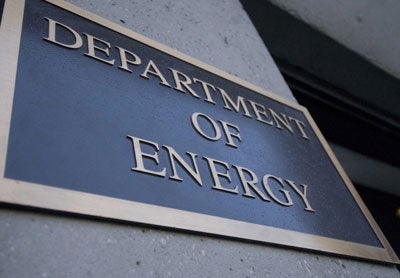Department of Energy: Working Hard to Give Away Your Money
Nicolas Loris /
This week the Department of Energy announced that it will make as much as $4 billion in loan guarantees available for renewable and energy efficiency projects that reduce, avoid, or sequester greenhouse gas emissions. The federal government needs to stop playing banker in an attempt to build the energy economy it wants by putting taxpayers’ money at risk. Instead, DOE should allow the private sector to reward the risk takers and innovators of the energy world.
DOE’s press release says that the loan guarantee solicitations are meant to “help overcome the financial barriers to the deployment of innovative, clean energy technologies” and “support technologies that are catalytic, replicable, and market ready.”
But, if a technology is market ready and cost competitive, it should have no trouble securing private sector financing.
In a Senate Energy and Natural Resources Committee hearing last year, Ethan Zindler, head of policy analysis for Bloomberg’s New Energy Finance, testified that:
I would argue that there is no shortage of capital (debt, equity, so-called tax equity, or other) available for high quality clean energy projects—that is, projects being developed by reputable companies, with relevant permits in hand, and most importantly, firm, long-term agreements signed to sell electricity at a reasonable price to a credit-worthy buyer such as a major utility. The financial community will gladly underwrite such a project.
Zindler goes on to note that, currently, a number of projects lack such criteria. When economically uncompetitive technologies and companies cannot attract private financing, there is usually a good reason why. These investors are using political calculus to hedge their bets, and we’ve witnessed more than a dozen taxpayer-funded failures as a result.
Supporters of the DOE guarantees argue a few failures are worth the risk and the numbers of success stories far outweigh those of bankrupt or struggling companies. But even if a project receives a government investment, it is a mistake to attribute that company’s success to the federal government.
There are companies that would, and often do, receive investment from the private sector because their technology is profitable or because investors find their technology promising and want to pursue the risk. In these cases, the government’s investment partially offsets private-sector investments that would have been made without federal backing.
In other cases, the government investment is blatant corporate welfare. For example, Cogentrix of Alamosa received a loan guarantee for $90.6 million. Cogentrix is owned by a subsidiary of Goldman Sachs. Further, NRG’s biggest loan guarantee was for its BrightSource project, where NRG’s partners include subsidiaries of BP, Chevron, and Statoil. If Big Banking and Big Oil cannot finance a project, maybe the project isn’t worth financing. And if it is worth financing, why are the taxpayers putting their money on the line?
The merits of all energy projects, including renewable and efficiency projects, should be based on whether they can compete in the marketplace, not whether they qualify for a government program that risk taxpayers’ money.

